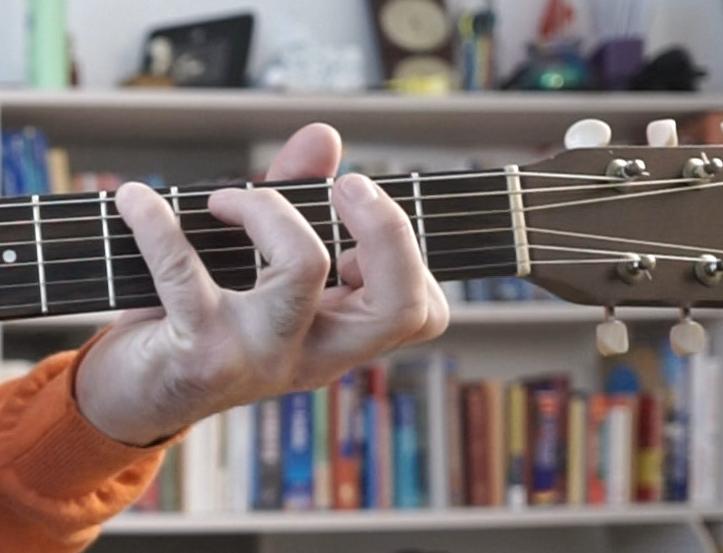Here are 9 things you can do right now to improve your fretting hand speed and fret the guitar faster.
When you are starting out with guitar, you will likely spend most of your efforts just remembering where to put your fingers.
Later, though, you must put some effort into improving your fretting hand speed.
You will naturally improve your fretting hand speed as time goes on and you continue to practice and improve at playing fingerstyle guitar.
But did you know that there are 9 key things that you can do right now to improve your fretting hand speed?
Let's look at each of these techniques to improve your fretting hand speed in more detail.
1. Cheating
The number one technique that you can use to improve your fretting technique is to do what I call cheating.
In this case, cheating at guitar is actually a positive thing. It sounds great when you incorporate it into your playing.
And if you do it well, your listener won’t be able to tell that you are cheating.
Cheating involves playing open strings while you do a chord change, in order to give yourself more time to change between two chords or positions on the guitar neck.
You can perform cheating by plucking a bass note with your thumb as your fretting hand moves from one chord to the next.
If you find that you don’t have enough time to fret the next chord when performing a chord change, this cheating technique will give your hand ample time to switch from one chord to the next without rushing.
2. Play Simpler Chords
You can improve your fretting hand speed in fingerstyle guitar almost instantly just by playing simpler chords.
If you have a chord that requires you to fret all four fingers, try to play the same chord using fewer fingers. You can accomplish this by using an alternate fingering for your chord.
Luckily on guitar, a note can be found in several positions on the fretboard. You can also use an open string, which we will discuss below.
You may also be able to remove some notes from your chord. If this is a chord such as a dominant seventh chord, you can often drop a note such as the fifth and still maintain the proper harmonic function of the chord.
3. Use Open Strings
Another way to simplify your fretting hand and increase your speed is to use open strings in your arrangement. This ties into our section about alternate fingerings that we discussed above.
To use open strings in order to improve your guitar fretting hand, try replacing a note that requires a finger with an open string. This note can be a unison note or at a different octave.
You may run into trouble trying to use open strings if your arrangement is in a key that doesn’t allow for it, such as A flat major. If your arrangement currently does not allow for using open strings, you can change the key of the arrangement by using a capo.
4. Use Alternate Tunings
With alternate tunings, you can play melodies that sound exotic with very few fingers on the fretboard. This is due to the vast number of open strings that you can play.
DADGAD tuning has many simple chords that are easy to finger and sound great. Also, if you need to cheat, you can just strum away in DADGAD, just like Sungha Jung does in his song Sprint. Sungha Jung uses this cheating method extensively in Irony, another song that uses an alternate tuning.
Alternate tunings also allow you to use the same chord shape up and down the guitar. If you find that your fretting hand moves at an inferior speed than your picking hand, this method could be a game changer.
5. Understand Proper Finger Placement
You can improve your fretting hand speed by choosing more ergonomic chord shapes. Here are 3 things to avoid when aiming for faster chord placement:
- inverted fingers (i.e. placing the pinky above the ring finger)
- extremely wide spaces between fingers
- complicated barre chords (B Major shape)
By avoiding awkward finger placement and sticking to natural chord formations, such as the basic chord shapes (think G Major or D Major chords), you will be able to improve your fretting speed and play much faster.
6. Don't Use Big Stretches
Big stretches are usually awkward and are extremely hard to fret in a quick period. Therefore, big stretches actually don’t work very well for accuracy in fast passages.
When you stretch your fingers over a wide distance, your fingertips may not land properly on the fretboard. Therefore, you may not be able to exert even pressure on the strings. This can also cause tension in your hand and wrist, which can lead to pain or injury over time.

Instead of stretching your fingers to reach a wide interval, you can shift your hand position to play the notes more comfortably.
For example, if you need to play a note that is two frets away from your current position, you can shift your hand up or down the fretboard to reach the note more easily.
7. Use Legato Technique
In fingerstyle guitar, generally every single note is plucked. This isn’t the case with licks that use pull-offs and hammer-ons. These legato techniques help us avoid individually plucking all the notes.
If the passage you are playing doesn't allow for an easy fingering, you can slur into the note that precedes the awkward fingering.
This means that instead of plucking the note, you slide or hammer-on/pull-off to the note. This allows you to avoid an awkward string crossing and play the notes more smoothly.
8. Play With Precise Fingering Patterns
Were you taught this method: play the lick over and over again, slowly at first, then faster, and the speed will come naturally? This is not very good advice; some licks are impossible to speed up due to fingering pattern problems.
You need to practice a lick slowly using the exact fingering pattern that you will use when you will be playing quickly. Practicing slowly with the correct fingering pattern helps you to play the lick accurately when you eventually increase the speed.
9. Make Sure Your Fretting Hand Is Efficient
If you are unable to “nail” a certain passage with fingerstyle guitar, check that your left hand fingering isn’t causing you any issues. For instance, if your left hand fingers are not placed correctly on the frets, it can cause the notes to sound muted or unclear.
Play the passage slowly and use all the techniques in this article to analyze or “audit” your fretting hand. Tension in the left hand can also cause pain or discomfort, which can make it difficult to practice for extended periods of time.
For more strategies on how to avoid tensing up, and for techniques on ensuring your finger movement is efficient, check out my premium course for learning fingerstyle guitar, called Play Fingerstyle Guitar Now!



